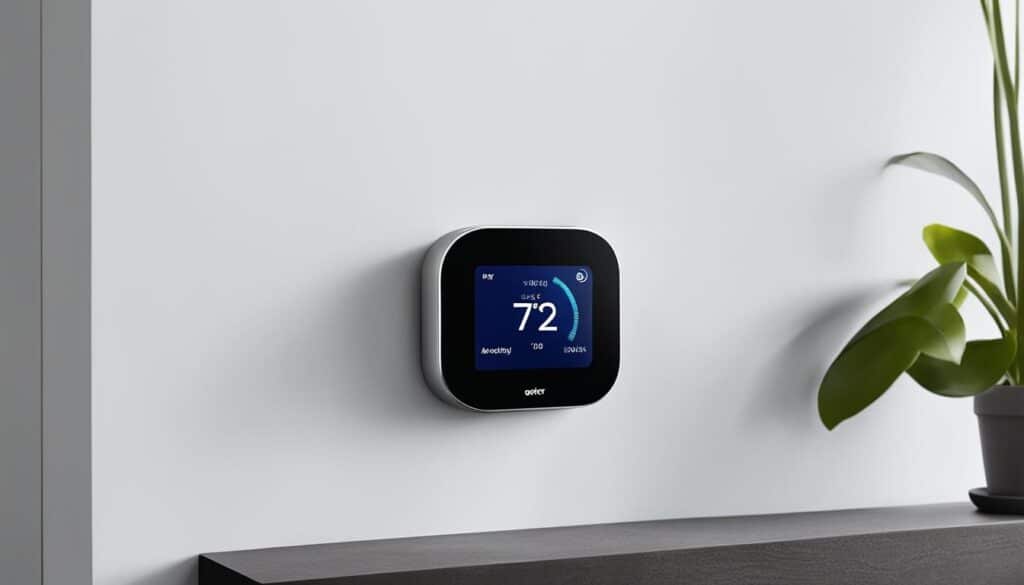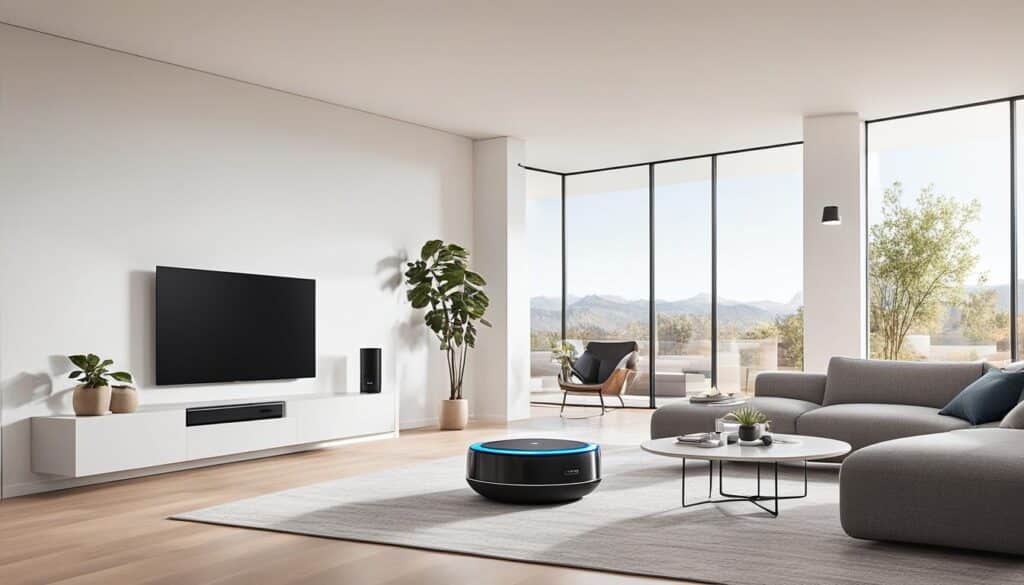Setting up a smart home can seem overwhelming, but with the right guidance, it can be a simple and convenient process. In this guide, I will walk you through the steps to create your first smart home, catering specifically to novices who are new to this technology. By following these simple smart home setups, you can seamlessly integrate smart devices into your living space and enjoy the benefits of a connected home environment.
Table of Contents
Key Takeaways:
- Setting up a smart home doesn’t have to be complicated, even for novices.
- Smart home technology allows for remote control and automation of various functions in your home.
- Choosing the right smart devices that are compatible with each other is essential for a successful setup.
- Follow a step-by-step guide to ensure a seamless and hassle-free smart home setup.
- Enjoy the convenience and connectivity of your new smart home.
Understanding Smart Home Basics
Before diving into the setup process, it’s essential to understand the basics of smart home technology. Smart home devices are interconnected devices that can be controlled remotely through a smartphone or voice assistant.
These devices can range from smart lights and thermostats to security cameras and virtual assistants like Amazon Echo or Google Home. By connecting these devices to your home’s Wi-Fi network, you can control and automate various functions within your home, enhancing convenience, energy efficiency, and security.
Smart home technology provides a seamless and integrated experience, allowing you to create personalized settings and routines. With a touch of a button or a simple voice command, you can adjust the lighting, change the temperature, monitor your home, and even play your favorite music.
Connected devices work together in harmony, enabling you to create a smart ecosystem where your devices communicate and respond to your needs. Imagine walking into a room, and the lights automatically turn on, the blinds lower, and your preferred music starts playing, all customized to your preferences.
Whether you’re looking to add convenience, energy efficiency, or peace of mind, smart home technology offers endless possibilities. With the ability to control and monitor your home from anywhere, you can have complete peace of mind, knowing that your home is safe and energy-efficient.
The Benefits of Smart Home Technology:
- Convenience: Control your home’s functions with a simple voice command or a tap on your smartphone.
- Energy Efficiency: Optimize energy usage by automatically adjusting lighting, temperature, and other devices.
- Security: Monitor your home remotely, receive alerts, and enhance the security of your living space.
- Personalization: Customize settings and routines to fit your lifestyle and preferences.
- Integration: Seamlessly integrate multiple devices and create a smart ecosystem.
“Smart home technology offers a new level of convenience and control. From managing your lighting and climate to monitoring your home’s security, the possibilities are endless.”
In the next section, we will explore how to select the right smart devices based on your specific needs and preferences.
Choosing the Right Smart Devices
When setting up your smart home, it’s crucial to choose the right smart devices that suit your needs and preferences. Consider the specific functionalities you want from your smart home, such as lighting control, climate control, or home security. Research and compare different smart devices available in the market, ensuring they are compatible with each other and can be easily integrated into your smart home ecosystem.
Some popular smart devices to consider include:
- Smart Lights
- Smart Thermostats
- Smart Plugs
- Smart Locks
- Smart Speakers
Smart lights allow you to control the lighting in your home remotely, creating a personalized ambiance and saving energy. Smart thermostats help you regulate your home’s temperature and optimize energy usage. Smart plugs enable you to turn on or off any connected device with a simple voice command or through your smartphone. Smart locks provide enhanced security by allowing you to lock and unlock your doors with ease, even when you’re away from home. Smart speakers, such as the popular Amazon Echo or Google Home, act as the central hub for your smart home, allowing you to control all connected devices through voice commands.
Remember to choose smart devices that are compatible with your existing home infrastructure to ensure seamless integration and a hassle-free smart home experience.

| Smart Device | Main Functionality | Compatibility | Price Range |
|---|---|---|---|
| Smart Lights | Remote control of lighting, energy savings | Compatible with popular smart home platforms | $20 – $100 per bulb/set |
| Smart Thermostats | Temperature control, energy optimization | Compatible with most heating and cooling systems | $150 – $300 |
| Smart Plugs | Remote control of connected devices | Compatible with most electrical outlets | $15 – $50 per plug |
| Smart Locks | Keyless entry, enhanced home security | Compatible with most standard door locks | $100 – $300 |
| Smart Speakers | Voice control, central hub for smart home | Compatible with multiple smart home platforms | $50 – $250 |
Setting Up Your Smart Home
Once you have selected your smart devices, it’s time to start setting up your smart home. Follow these step-by-step instructions to ensure a successful setup:
- Connect to Wi-Fi: Begin by connecting your smart home hub or bridge to your home’s Wi-Fi network. Most smart devices require a stable internet connection to function properly.
- Install and configure the hub: If your smart devices require a central hub or bridge, install it according to the manufacturer’s instructions. This hub will act as the control center for all connected devices.
- Pair your devices: Follow the pairing instructions for each smart device. This may involve scanning a QR code, pressing a button on the device, or using a specific app for setup.
- Add devices to the hub: Once paired, add each smart device to your hub or bridge. This will enable communication between your devices and allow you to control them from a single interface.
- Set up automation: Take advantage of the automation features offered by your smart home system. Configure routines, schedules, and triggers to automate tasks such as turning on lights at a specific time or adjusting the thermostat when you leave home.
- Install smart home apps: Download and install the corresponding apps for your smart devices on your smartphone or tablet. These apps will provide you with additional control and customization options for each device.
- Test and troubleshoot: Test the functionality of each device to ensure it’s working as expected. If you encounter any issues, consult the manufacturer’s troubleshooting guide or contact their support team for assistance.
By following these simple steps, you can quickly and effectively set up your smart home. Enjoy the convenience and control that smart devices bring to your everyday life!

Conclusion
Congratulations on successfully setting up your first smart home! By following this novice’s guide to simple smart home setups, you have transformed your living space into a connected and convenient environment.
Now, you can enjoy the benefits of controlling your home’s functions with a simple voice command or a tap on your smartphone. With smart home technology, you have the power to enhance your daily routines, save energy, and improve the overall comfort and security of your home.
So sit back, relax, and revel in the convenience and connectivity of your new smart home. Embrace the endless possibilities that smart devices bring to your fingertips and discover a world of seamless integration and automation.
FAQ
What is a smart home?
A smart home is a living space equipped with interconnected devices that can be controlled remotely through a smartphone or voice assistant.
What are some examples of smart home devices?
Some examples of smart home devices include smart lights, smart thermostats, smart plugs, smart locks, and smart speakers.
How do I choose the right smart devices for my home?
When choosing smart devices, consider the functionalities you want, such as lighting control, climate control, or home security. Research and compare different smart devices, ensuring they are compatible with each other and can be easily integrated into your smart home ecosystem.
How do I set up my smart home?
Follow the step-by-step instructions in the guide to set up your smart home. Make sure you have selected the right smart devices that suit your needs, and ensure they are compatible with each other. Connect the devices to your home’s Wi-Fi network and follow the manufacturer’s instructions for installation and setup.
What are the benefits of a smart home?
A smart home offers convenience, energy efficiency, and enhanced security. You can control your home’s functions with a simple voice command or a tap on your smartphone, automate routines, save energy, and improve the overall comfort and security of your home.
